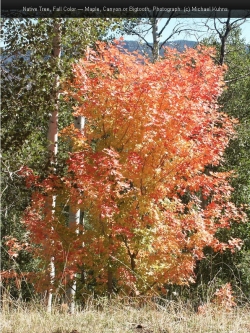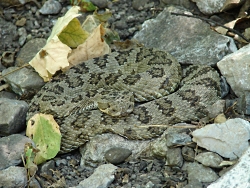
In a natural landscape
Acer grandidentatum
Courtesy Michael Kuhns
Extension.usu.edu
Holly: Hi, I’m Holly Strand from Stokes Nature Center in beautiful Logan Canyon.
The canyons and valleys of Utah will soon be awash with brilliant fall hues. Cascades of red, orange and gold will blanket the hillsides as the weather turns cooler and morning frost dusts the mountain ridges.
The Canyon Maple is one of Utah’s main sources of autumn color. Like most maple species, its leaves are carved into deep lobes. The leaves are medium-to-bright green now, but soon the entire tree will glow with spectacular color.
Canyon maple is found throughout Utah at medium elevations between 4,500 to 7,500 feet. It tends to grow on lower slopes and canyon bottoms in the mountains in association with Douglas-fir and junipers.
Its scientific name, Acer grandidentatum [AY-ser gran-dih-den-TAY-tum], means “Big Tooth”, referring to the tree’s distinctive lobed leaves with large, toothed margins. In fact, bigtooth maple is another common name for this species.

In a natural landscape
Acer grandidentatum
Courtesy Michael Kuhns
Extension.usu.edu
Some think that he canyon maple is related to the sugar maple of the northeastern and midwestern United States,” says forestry professor Mike Kuhns of Utah State University’s Department of Wildland Resources. It’s possible that long ago, the Rocky Mountains rose up and isolated a sugar maple population that eventually evolved into a unique species.
The canyon maple rivals its eastern relatives in fall color but does it produce sap suitable for tasty, syrup-covered waffles and pancakes? Back in 1970s, a group of scientists set out to determine just that. The trees were tapped and yielded plenty of sticky liquid. The color was very light, resembling light honey and the flavor was delicate and fruity, almost like pineapple. However, it was notably less sweet than the northeastern sugar maple. Of 30 panelists from Utah who participated in a taste test, 57 percent preferred eastern sugar maple syrup but the remaining 43 percent preferred canyon maple syrup.

leaves in late summer
Acer grandidentatum
Courtesy Michael Kuhns
The researchers concluded that while canyon maple sap was not practical for large-scale syrup production it might be enjoyable for individuals to try on a small scale on private land within its habitat range.
Syrup aside, the medium-sized tree thrives in Utah’s residential landscapes, parks and urban areas, as well as in the wild. Its year-round beauty, hardiness and manageable size make it a perennial favorite in the Beehive State.
Thanks to the USU College of Natural Resources for supporting research and development of this Wild About Utah topic.
For Wild About Utah and Stokes Nature Center, I’m Holly Strand.
Credits:

leaves in late summer & fall
Acer grandidentatum
Courtesy Michael Kuhns
Extension.usu.edu
Image: Courtesy and Copyright 2003 Michael Kuhns, Extension.usu.edu
Text: Holly Strand & Mary-Ann Muffoletto, Stokes Nature Center
Sources & Additional Reading
Barker, Phillip A.; Salunkhe, D. K. 1974. Maple syrup from bigtooth maple. Journal of Forestry. 72(8): 491-492. [9065] https://www.ingentaconnect.com/content/saf/jof/1974/00000072/00000008/art00016
Kuhns, Michael. 2003. Canyon Maple: A Tree For the Interior West,” USU Forestry Extension, https://extension.usu.edu/forestry/HomeTown/Select_CanyonMaple.htm [2009, September 16].
Tollefson, Jennifer E. 2006. Acer grandidentatum. In: Fire Effects Information System, [Online]. U.S. Department of Agriculture, Forest Service, Rocky Mountain Research Station, Fire Sciences Laboratory (Producer). Available: https://www.fs.fed.us/database/feis/ [2009, September 16]
Acer grandidentatum – Bigtooth Maple, Water-wise Plants for Utah Landscapes, https://www.waterwiseplants.utah.gov/default.asp?p=PlantInfo&Plant=17




